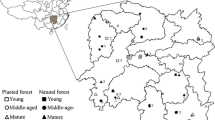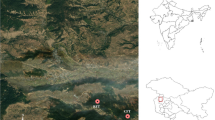Abstract
Chir pine (Pinus roxburghii) is the most important tree species used for afforestation programs in the Himalayan regions. In the present study, fourteen forest stands were selected in four different altitudes, i.e., < 1000, 1001–1400, 1401–1800, and > 1801 masl in Garhwal Himalayan of Uttarakhand, India, to assess carbon stock potential of the forest. The study was conducted during 2013–2015. Among the study sites, the maximum tree density (575 ± 90.14 ind. ha−1) was reported in New Tehri (altitude: > 1801 masl) and minimum (135 ± 5.00 ind. ha−1) in Daddi (altitude: 1001–1400 masl). The highest (96 ± 18.36 t ha−1) above-ground carbon stock was estimated in Kandikhal where bole, branch, and foliage contribute 89.93 ± 19.47, 5.17 ± 1.04 and 0.90 ± 0.14 t ha−1, respectively, while lowest (26.68 ± 9.48 t ha−1) was in Gumkhal, and contribution from the same component was found as 20.72 ± 7.84, 4.50 ± 1.58, and 1.47 ± 0.11 t ha−1, respectively. Further, highest value of below-ground carbon was in Kandikhal (28.58 ± 4.81 t ha−1) with an altitude range between 1001 and 1400 masl and the lowest in Gumkhal (9.19 ± 2.87 t ha−1) between 1401 and 1800 masl. Besides, litter production was found higher in the summer season followed by winter and rainy seasons. The study concluded that the density, height, basal area, and volume of Pinus roxburgii varied with altitude, but it was not directional. However, growth patterns and tree density were the key factors in estimating total carbon stocks and further to know the behavior of carbon dynamics (source/sink). Litter production had an inverse relation with altitude; however, increase in litter biomass at > 1801 masl was observed due to new plantations of pine. This study will be highly helpful to the forester and policy-makers in planning carbon mitigation strategies (e.g., catchment area treatment, afforestation activities) at regional and global scales.





Similar content being viewed by others
References
Amatya, S. M. (2002). Nepal Forestry Handbook. Italy, Rome: FAO.
Batar, A. K., Teiji, W., & Kumar, A. (2017). Assessment of land-use/land-cover change and forest fragmentation in the Garhwal Himalayan region of India. Environments, 4, 34.
Bhattacharyya, T., Pal, D. K., Chandran, P., Ray, S. K., Mandal, C., & Talpande, B. (2008). Soil carbon storage capacity as a tool and to prioritize area for carbon sequestration. Current Science, 95(4), 482–484.
Bitlerlich, W. (1984). The relaskop idea slough: Commonwealth agricultural bureause. England: Farnham Royal.
Chaturvedi, R. K., Gopalakrishnan, R., Jayaraman, M., Bala, G., Joshi, N. V., Raman, S., & Ravindranath, N. H. (2010). Impact of climate change on Indian forests: A dynamic vegetation modeling approach. Mitigation and Adaptation Strategies for Global Chang, 16(2), 119–142.
Chidumaya, E. N. (1990). Aboveground woody biomass structure and productivity in a zambezian woodland. Forest Ecology and Management, 36, 33–46.
FSI. (2017). India State of Forest Report. Dehra Dun, Forest Survey of India, Ministry of Environment and Forests: Government of India.
Gairola, S., Rawal, R. S., & Todaria, N. P. (2008). Forest vegetation patterns along an altitudinal gradient in Sub-alpine zone of West Himalaya India. African Journal of Plant Science, 2(6), 42–48.
Ghildiyal, S. K., Sharma, C. M., & Gairola, S. (2009). Environmental variation in seed and seedling characteristics of Pinus roxburghii Sarg. from Uttarakhand. India. Applied Ecology Environment Research, 7, 121–129.
Ghimire, P. (2019). Carbon sequestration potentiality of Pinus roxburghii forest in Makawanpur District of Nepal. Journal of Energy, Environmental and Chemical Engineering, 4(1), 7–12.
Ghimire, P., Bhatta, B., Pokhrel, B., Sharma, B., & Shrestha, I. (2018). Assessment of soil quality for different land uses in the Chure region of Central Nepal. Journal of Agriculture and Natural Resources, 1(1), 32–42.
Singh, G., Giri, A., & Paul, S. (2017). Pinus roxburghii Sarg (Chir pine): A valuable forest resources of Uttarakhand. Indian forester, 143(7), 700–709.
Gupta, B., Mehta, R., & Mishra, V. K. (2009). Fire ecology of ground vegetation in pinus roxburghii sargent plantations in North-West Himalaya - floristic composition and species diversity. Caspian Journal Environmental Science, 7(2), 71–78.
Hairiah, K., Sitompul, S.M., Noordwijk, M., Palm, C. (2001). Methodology for sampling carbon stocks above and below ground. ASB Lecture Notes 4B. International Centre for Research in Agro forestry, Indonesia, Published in http://www.icraf.cgiar.org/sea
Jianmin, X., & Zhing, W. U. (2007). Economic benefit analysis of carbon sequestration of five typical forest types in Beijing Miyun watershed. Chinese Forestry Science and Technology, 6(1), 57–61.
Koul, D. N., & Panwar, P. (2008). Prioritizing land- management options for carbon sequestration potential. Current Science, 95, 658–663.
Kumar, A., & Sharma, M. P. (2017). Estimation of greenhouse gas emissions from Koteshwar hydropower reservoir, India. Environmental Monitoring and Assessment, 189, 240. https://doi.org/10.1007/s10661-017-5958-7.
Kumar, A., Mishra, S., & Kumar, A. (2017a). Environmental quantification of soil elements in the catchment of hydroelectric reservoirs in India. Human and Ecological Risk Assessment: An International Journal, 23(05), 1202–1218.
Kumar, A., Sharma, M. P., & Taxak, A. K. (2017b). Effect of vegetation communities and altitudes on the soil organic carbon stock in kotli Bhel-1A catchment, India. Clean–Soil, Air & Water, 45(8), 1–8.
Kumar, A., Sharma, M. P., & Yang, T. (2018). Estimation of carbon stock for greenhouse gas emissions from hydropower reservoirs. Stochastic Environmental Research Risk Assessment, 32(10), 3183–3319.
Kumar, A., Yang, T., & Sharma, M. P. (2019a). Greenhouse gas measurement from chinese freshwater bodies: A review. Journal of Cleaner Production, 233, 368–378.
Kumar, M. (2015). Carbon stock in standing dead trees of Pinus roxburghii sarg. in sub-tropical part of Garhwal Himalaya. Forestry Ideas, 21, 75–83.
Kumar, M., & Pandey, R. (2017). Carbon stock loss of Chir pine forest through tree felling in Lower Himalaya. Environmental Risk Assessment and Remediation, 1(1), 19–21.
Kumar, M., KumarKonsam, R. B., Sheikh, M. A., & Pamdey, R. (2019b). Above- and below-ground biomass production in Pinus roxburghii forests along altitudes in Garhwal Himalaya. India Current Science, 116(9), 1506–1514.
Kumar A, Kumar M (2020) Estimation of Biomass and Soil Carbon Stock in the Hydroelectric Catchment of India and its implementation to Climate Change. Journal Sustainable Forestry 39 (6), https://doi.org/10.1080/10549811.2020.1794907
Kumar, S., & Tewari, L. M. (2015). Pattern of litter fall in pinus roxburghiisarg. forest in Kumaun Himalaya. Indian Journal of Ecology, 42, 219–223.
Luna, R. K. (2005). Plantation trees. Dehrudun, India: International Book Distributors.
Mishra, B. K. (2017). Assessment of the soil and tree carbon stocks of a Chir pine forest in Garhwal Himalaya India. International Journal of Geology, Earth and Environmental Sciences, 7(2), 19–24.
Pant, H., & Tewari, A. (2014). Carbon sequestration in Chir-Pine (Pinus roxburghii Sarg.) forests under various disturbance levels in Kumaun Central Himalaya. Journal of Forestry Research, 25, 401–405.
Petrokofsky, G., Kanamaru, H., Achard, F., et al. (2012). Comparison of methods for measuring and assessing carbon stocks and carbon stock changes in terrestrial carbon pools how do the accuracy and precision of current methods compare? A systematic review protocol. Environ Evid, 1, 6. https://doi.org/10.1186/2047-2382-1-6.
Post, W. M., Emanuel, W. R., Zinke, P. J., & Stangenberger, A. G. (1982). Soil carbon pools and world life zones. Nature, 298, 156–159.
Pressler, M. (1895) Das Gesetz der Stambildung Leipzig.153.
Rajeev, S., Tewari, A. & Negi, G.C.S. (2011) Valuation of Ecosystem Services and Forest Governance: A scoping study from Uttarakhand. LEAD, India, Heinrich Boll Foundation, New Delhi, pp.1, https://in.boell.org/sites/default/files/valuation_of_ess_.pdf.
Rana, K., Kumar, M., & Kumar, A. (2020). Assessment of annual shoot biomass and carbon storage potential of grewia optiva: An approach to combat climate change in Garhwal Himalaya. Water, Air, & Soil Pollution, 231, 450. https://doi.org/10.1007/s11270-020-04825-2.
Ravindranath, N. H., Joshi, N. V., Sukumar, R., & Saxena, A. (2006). Impact of climate change on forests of India. Current Science, 90(3), 354–361.
Roy, P. S., & Tomar, S. (2000). Biodiversity characterization at landscape level using geospatial modelling technique. Biological Conservation, 95, 95–109.
Seth, S.K. (1980). Forests and forestry in Himalayan region. In: Proceedings of National Seminar on Resource Development and Environment in the Himalayan Region. Department of Science and Technology, New Delhi
Sharma, S., & Roy, P. S. (2007). Forest fragmentation in the Himalaya: A Central Himalayan case study. International Journal of Sustainable Development and World Ecology, 14, 201–210.
Sharma, S. K., & Verma, S. K. (2011). Influence of season on the rooting response of chir pine (Pinus roxburghii Sarg.). Annals Forests Resesrch, 54, 241–247.
Silori, G. K., Pant, G., Singh, J. K., Kumar, P., Rana, M. S., & Rana, R. S. (2013). Hay and tendril classifiable deforestation of pine and its impacts-a survey of Himalayan region in India. IOSR. Jornal Environment Science Toxicology and Food Technology, 6, 6–14.
Singh, J. S., & Singh, S. P. (1992). Forests of the Himalaya: Structure, functioning and impact of man. Gyanodaya Prakashan, 84(89), 142.
Singh, J. S., Tiwari, A. K., & Saxena, A. K. (1985). Himalayan forests: a net source of carbon to the atmosphere. Environmental Conservation, 12, 67–69.
Singh, N., Parida, B. R., Charakborty, J. S., & Patel, N. R. (2019). Net ecosystem exchange of CO2 in deciduous pine forest of lower Western Himalaya. India Resources, 8, 98. https://doi.org/10.3390/resources8020098.
Woomer, P. L. (1999). Impact of cultivation of carbon fluxes in woody savannas of southern Africa. Water Air Soil Pollution, 70, 403–412.
Acknowledgement
Authors are also thankful to Forest Department of Uttarakhand to provide permission to work in the Chir pine forest in different district. Authors are also thankful to the Department of Forestry and Natural Resources, HNB Garhwal University to provide facilities and necessary support during this study.
Funding
First author (MK) is thankful to the Science and Engineering Research Board (SERB)-Department of Science and Technology, New Delhi, for financial assistance for the study (Grant Number: SB/EMEQ-205/2013).
Author information
Authors and Affiliations
Contributions
MK designed the study, MK, RK, BK collected and analyzed the data and developed the manuscript, AK generated new concept, analyzed data, and finally edited manuscript; NAP and JAB read manuscript and provided suggestions to improve the quality of MS.
Corresponding author
Ethics declarations
Consent to participate
yes.
Consent for publication
Yes.
Additional information
Publisher's Note
Springer Nature remains neutral with regard to jurisdictional claims in published maps and institutional affiliations.
Rights and permissions
About this article
Cite this article
Kumar, M., Kumar, A., Kumar, R. et al. Carbon stock potential in Pinus roxburghii forests of Indian Himalayan regions. Environ Dev Sustain 23, 12463–12478 (2021). https://doi.org/10.1007/s10668-020-01178-y
Received:
Accepted:
Published:
Issue Date:
DOI: https://doi.org/10.1007/s10668-020-01178-y




